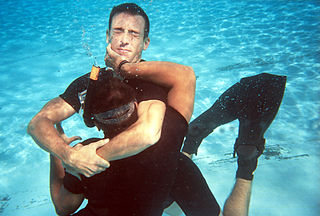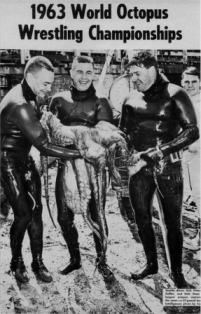 W
WAquathlon is an underwater sport, where two competitors wearing masks and fins wrestle underwater in an attempt to remove a ribbon from each other's ankle band in order to win the bout. The "combat" takes place in a 5-metre (16 ft) square ring within a swimming pool, and is made up of three 30-second rounds, with a fourth round played in the event of a tie. The sport originated during the 1980s in the former USSR and was first played at international level in 1993. It was recognised by the Confédération Mondiale des Activités Subaquatiques (CMAS) in 2008. Combat aquathlon practice training engagements not only under water, but also afloat, above the water surface, both with or without diving gear, utilizing dummy weapons or barehanded, combined with grappling and choking techniques in order to neutralize or submit the opponent.
 W
WFinswimming is an underwater sport consisting of four techniques involving swimming with the use of fins either on the water's surface using a snorkel with either monofins or bifins or underwater with monofin either by holding one's breath or using open circuit scuba diving equipment. Events exist over distances similar to swimming competitions for both swimming pool and open water venues. Competition at world and continental level is organised by the Confédération Mondiale des Activités Subaquatiques (CMAS). The sport's first world championship was held in 1976. It also has been featured at the World Games as a trend sport since 1981 and was demonstrated at the 2015 European Games in June 2015.
 W
WFreediving, free-diving, free diving, breath-hold diving, or skin diving is a form of underwater diving that relies on breath-holding until resurfacing rather than the use of breathing apparatus such as scuba gear.
 W
WUnderwater hockey (UWH), also known as Octopush is a globally played limited-contact sport in which two teams compete to manoeuvre a puck across the bottom of a swimming pool into the opposing team's goal by propelling it with a hockey stick or pusher). A key challenge of the game is that players are not able to use breathing devices such as scuba gear whilst playing, they must hold their breath. The game originated in England in 1954 when Alan Blake, a founder of the newly formed Southsea Sub-Aqua Club, invented the game he called Octopush as a means of keeping the club's members interested and active over the cold winter months when open-water diving lost its appeal. Underwater hockey is now played worldwide, with the Confédération Mondiale des Activités Subaquatiques, abbreviated CMAS, as the world governing body. The first Underwater Hockey World Championship was held in Canada in 1980 after a false start in 1979 brought about by international politics and apartheid.
 W
WA monofin is a type of swimfin typically used in underwater sports such as finswimming, free-diving and underwater orienteering. It consists of a single or linked surfaces attached to both of the diver's feet. The diver's appearance is then reminiscent of a mermaid or merman.
 W
WOctopus wrestling involves a diver grappling with a large octopus in shallow water and dragging it to the surface.
 W
WOmer is the name of a series of human-powered submarines. The submarines were built by students of the École de technologie supérieure in Montreal, Quebec, for the International Submarine Races. As of 2014, Omer teams hold the human-powered submarine world speed records for two-seater and non-propeller categories. Those records are :
 W
WUnderwater football is a two-team underwater sport that shares common elements with underwater hockey and underwater rugby. As with both of those games, it is played in a swimming pool with snorkeling equipment.
 W
WUnderwater orienteering is an underwater sport that uses recreational open circuit scuba diving equipment and consists of a set of individual and team events conducted in both sheltered and open water testing the competitors competency in underwater navigation. The competition is principally concerned with the effectiveness of navigation technique used by competitors to swim an underwater course following a route marked on a map prepared by the competition organisers, a compass and a counter meter to measure the distance covered. The sport was developed in the Soviet Union during the late 1950s and is currently played mainly in Europe. It is known as Orientation Sub in French and as La Orientación Subacuática in Spanish. Historically, the sport has also been known as Technical Disciplines.